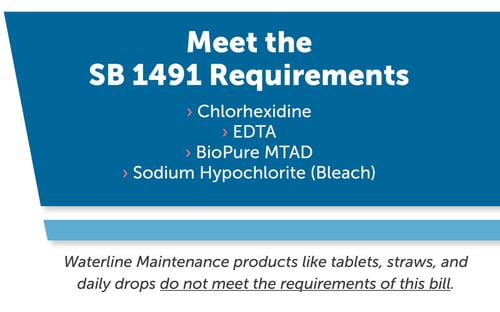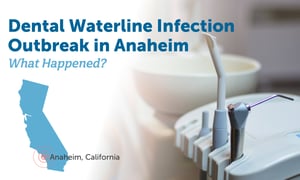There has been a lot of confusion surrounding California's recent legislation concerning dental water. This post is going to clear that up once and for all.
ProEdge has consulted with the Dental Board of California and the California Dental Association to make sure you know exactly what is required in this new legislation.
AB 1277 & SB 1491 - What do they govern?
First, Assembly Bill (AB) 1277 was established in May 2018 in response to the Dental Board of California's vote to make emergency rulemaking pursuant to California Business and Professions Code (BPC) Section 1601.6 after waterline contaminations caused infection outbreaks in California and Georgia. It stated:
SECTION 1. Section 1601.6 is added to the Business and Professions Code, to read: (a) Consistent with and in addition to the federal Centers for Disease Control and Prevention recommendations for water quality, the board shall amend the regulations on the minimum standards for infection control (Section 1005 of Title 16 of the California Code of Regulations) to require water or other methods used for irrigation to be sterile or contain recognized disinfecting or antibacterial properties when performing dental procedures that expose dental pulp.
However, Senate Bill (SB) 1491 was introduced on February 21, 2018 to repeal and replace AB 1277. Thus, AB 1277 is void.
SB 1491 clarified and narrowed the focus. Signed by the Governor on September 22, 2018 and in effect January 1, 2019, this bill states the following:
This bill makes using water, or other methods used for irrigation, that are not sterile or that do not contain recognized disinfecting or antibacterial properties when performing dental procedures on exposed dental pulp unprofessional conduct by a person licensed pursuant to the Dental Practice Act.
With little explanation, many dental practices, infection control experts, and manufacturers (including us!) believed safe dental waterline treatment was the point of the bill, but this is not the case.
SB 1491 does not govern dental water quality or dental unit waterline maintenance.
Instead, SB 1491 regulates the use of oral irrigants that are either sterile or confer antibacterial action on tissues like chlorhexidine, EDTA, BioPure MTAD and sodium hypochlorite (bleach) when dental pulp is exposed according CDA Regulatory Compliance Analyst Teresa Pichay.
What Does this means for your Practice?
A dentist must anticipate situations where pulp can be exposed. Whether expected and unexpected, anytime dental pulp is exposed, dentists must use sterile water or a disinfecting/antibacterial agent immediately to irrigate the exposed area of pulp.
For further information on performing dental procedures on exposed dental pulp, please reach out to the CDA.

Meet the SB 1491 Requirements:
- Chlorhexidine
- EDTA
- BioPure MTAD
- Sodium Hypochlorite (Bleach)
DO NOT Meet the SB 1491 Requirements (Waterline Maintenance Products):
- Daily Tablets (BluTab, Citrisil, ICX, Patterson, Z3, VistaTab)
- Straws / Cartridges / Filters (Sterisil, DentaPure, & Hu-Friedy)
- Daily Drops (TeamVista, MicroClear)
- Central Systems & R/O Units
- Shock Products (Liquid Ultra, Mint-A-Kleen, Monarch, VistaTab, Citrisil Shock)
Waterline maintenance products like tablets and straws contain low-level antimicrobials. While being vital for maintaining clean waterlines, they are a different classification under the EPA and do not qualify as having "recognized disinfecting or antibacterial properties".
The CDA does caution that "because dental handpieces are cooled by treated dental unit water, it is understood and accepted that treated dental water will be used during handpiece operation".
However! Regular Rulemaking on Waterline Maintenance Moving Foward
The Dental Board of California has initiated regular rulemaking to update the minimum standards for infection control as recommended by the subcommittee.
This specifically addresses the safety of your practice's waterlines.
In April and May of 2018, the Dental Hygiene Board and Dental Board approved the following addition to Section 1005 of the Minimum Standards for Infection Control (Page 408/462):
(22) Dental unit water lines shall be monitored following the instructions for use from the manufacturer of the dental unit or the dental unit waterline treatment product.
This would be in addition to the current dental water quality minimum standard:
(21) Dental unit water lines shall be anti-retractive. At the beginning of each workday, dental unit
lines and devices shall be purged with air or flushed with water for at least two (2) minutes prior to attaching handpieces, scalers, air water syringe tips, or other devices. The dental unit lines and devices shall be flushed between each patient for a minimum of twenty (20) seconds.
These new rules are currently under review by the Board Legal Counsel. Once this counsel approves, the Board staff will submit the rulemaking documents to the Department of Consumer Affairs to review prior to submitting the documents to the Office of Administrative Law for noticing. Per the Dental Board of California meeting on February 7th (timecode: 3:52:00), this is likely to take place within the next two months. Implementation could be 2019 or 2020.
Read your dental unit and treatment product instructions for use completely and follow them closely. Document your protocol and keep records in case of inspection or complaint.

DOWNLOAD the Proven 3 Steps to Safe Water PROTOCOL HERE:
Why all the attention on  Waterlines?
Waterlines?
In 2015 and 2016, two major infection outbreaks occurred in over 91 healthy patients from contaminated waterlines. The first happened in Georgia, and the second outbreak in Anaheim, California with 71 confirmed of mycobacterium abscessus.
As the numbers of linked cases grows, the attention from regulatory agencies grows as well. In 2018, the FDA announced their dental unit waterline guidelines for dental practices and dental device manufacturers. The Organization for Safety, Asepsis, and Prevention (OSAP) released one of the most comprehensive white papers on dental water quality to date with compelling recommendations for practice compliance included.
Reports from the field are also informing us that dental board and OSHA inspections are requiring to see waterline test results in accordance with the CDC Infection Prevention Checklist (Page 19).
5 Tips to Safe Water Compliance in California
1. Comply with SB 1491
Use sterile or water with recognized disinfecting or antibacterial properties whenever performing dental procedures on exposed dental pulp (See list of products that meet this requirement above).
2. Shock Your Waterlines Regularly
Shock your waterlines regularly. No matter what treatment product you use, the research shows shocking is vital.
3. Use a Daily or Continuous Waterline Treatment
Use a daily or continuous waterline treatment like BluTab or other tablets and straws.
4. Test Your Waterlines
Test your waterlines quarterly to ensure your protocol is effective. While every product can work, every product can also fail. The only way to know you're not wasting your money on shocks and treatments, is to test.
5. Get Your Practice a Partner in Waterline Maintenance
Get a partner. You didn't get into dentistry to maintain waterlines, but we did. Every one of our clients can consult with our water safety specialists to develop a proven protocol and learn best practices... free. Contact us today and we'll do all we can to help make sure waterline safety is checked off your list of worries.







